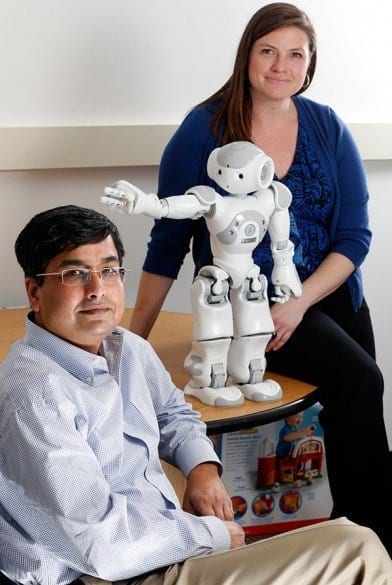
EuroMov, Center for Research and Technological Development, Montpellier, France
A collaborative research team has found humanoid robotics and computer avatars could help rehabilitate people suffering from social disorders such as schizophrenia or social phobia. It is thanks to the theory of similarity, which suggests that it is easier to interact socially with someone who looks, behaves or moves like us.
Researchers from the University of Bristol, in collaboration with colleagues at the Universities of Exeter, Montpellier and Naples Federico II, have developed a system to enable a robot or computer avatar to interact with a patient whilst playing a version of the mirror game, in which two players try to copy each other’s motion whilst playing with coloured balls that can move horizontally on a string.
The paper, part of the EU-funded AlterEgo project, is published in the Journal of the Royal Society Interface.
Initially the avatar is like an alter ego, created to look and move like the patient to enhance his or her feelings of attachment. Over time the avatar is slowly altered to become less similar, therefore helping with social rehabilitation.
The results show that players sharing similar movement features, or motor signature, interact and co-ordinate better. This can be used for rehabilitation of patients with serious social disorders as an avatar can be created to act like an alter ego, programmed to look and move like the patient to enhance his or her feelings of attachment.
Mario di Bernardo, Professor of Nonlinear Systems and Control from the Department of Engineering Mathematics at the University of Bristol, said: “It is very challenging to build an avatar that is intelligent enough to synchronise its motion with a human player, but our initial results are very exciting.”
The research used the principles of dynamical systems and feedback control theory to embed the avatar with enough ‘intelligence’ to synchronise and respond to the motion of the human player.
The researchers now wish to build on the technology and set-up multiple human-machine interaction for social rehabilitation and make groups of people and avatars interact with each other to perform joint tasks together.
Learn more: Humanoid robotics and computer avatars could help treat social disorders
The Latest on: Computer avatars
[google_news title=”” keyword=”computer avatars” num_posts=”10″ blurb_length=”0″ show_thumb=”left”]
via Google News
The Latest on: Computer avatars
- This Indonesian animator helped bring She-Hulk, Hawkeye and a kingdom of 'Apes' to lifeon May 9, 2024 at 5:26 pm
What’s it like to work for a major film studio? Sashya Subono Halse, the passionate Indonesian animator at Weta FX who worked on Disney’s Avatar: The Way Of Water, and Marvel’s She-Hulk and Hawkeye, ...
- How the 'Kingdom of the Planet of the Apes' movie sometimes put the cast in real dangeron May 9, 2024 at 7:30 am
A shoot in Australian jungles put the "Kingdom of the Planet of the Apes" cast up against real dangers in making the new movie (in theaters Friday).
- What happens when an AI avatar is given a priest's collar? | Terry Mattinglyon May 9, 2024 at 3:13 am
"Dressing it up as a soulless AI avatar of a priest does absolutely nothing except ... Answers "didn't anticipate that someone might seek sacramental absolution from a computer graphic!" For ...
- How the concept of the relevant consumer could shift in the metaverse under the Turkish classification systemon May 9, 2024 at 1:13 am
While revised guidelines from the Turkish Patent and Trademark Office aim to distinguish between types of consumers when it comes to buying goods and services, the metaverse raises questions about how ...
- MIT Technology Reviewon May 8, 2024 at 3:00 am
The same technologies are being used by Chinese people to make replicas of themselves, their children, and famous public figures.
- Walt Disney, Elvis Presley, and John Carpenter: The three icons who made Kurt Russellon May 6, 2024 at 10:15 am
Kurt Russell evolved from child star into an established actor before settling into his current groove as a grizzled veteran, but he was shaped along the way.
- What happens when AI avatar gets a priest’s collar?on May 4, 2024 at 12:55 am
"God is merciful and loving, my child," the bot concluded. "For your penance, I ask you to pray the Our Father three times, reflecting on God's infinite mercy and love. And now, I absolve you of your ...
- ON RELIGION: What happens when an AI avatar is given a priest's collar?on May 3, 2024 at 9:14 pm
The penitent crafted the perfect sin to confess to a virtual priest: “Bless me father, for I have sinned. ... I have had anger in my heart about the deployment ...
- How to Unhide or Hide Desktop icons in Windows 11/10on May 1, 2024 at 5:00 pm
This setting removes icons, shortcuts, and other default and user-defined items from the desktop, including Briefcase, Recycle Bin, Computer, and Network Locations. Removing icons and shortcuts ...
- Avatar World Codes (May 2024)on May 1, 2024 at 1:20 pm
The process of redeeming codes in Avatar World is more creative than in other similar games. After you use the code, you go to your room and a drone comes with a present. You have to pick up the ...
via Bing News










